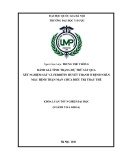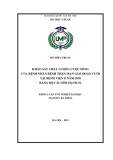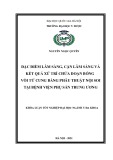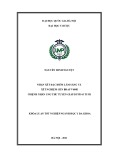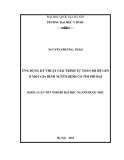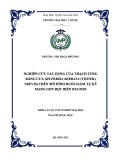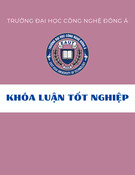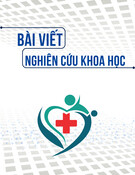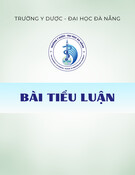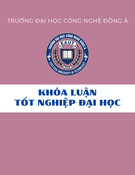
BioMed Central
Page 1 of 10
(page number not for citation purposes)
Implementation Science
Open Access
Study protocol
Study protocol for the translating research in elder care (TREC):
building context through case studies in long-term care project
(project two)
Jo Rycroft-Malone*1, Sue Dopson2, Lesley Degner3, Alison M Hutchinson4,
Debra Morgan5, Norma Stewart6 and Carole A Estabrooks4
Address: 1Centre for Health-Related Research, Bangor University, Bangor, UK, 2Said Business School, University of Oxford, Oxford, UK, 3Faculty
of Nursing, University of Manitoba, Winnipeg, MB, Canada, 4Faculty of Nursing, University of Alberta, Edmonton AB, Canada, 5Canadian Centre
for Health & Safety in Agriculture, University of Saskatchewan, Saskatoon, SK, Canada and 6College of Nursing, University of Saskatchewan,
Saskatoon, SK, Canada
Email: Jo Rycroft-Malone* - j.rycroft-malone@bangor.ac.uk; Sue Dopson - sue.dopson@sbs.ox.ac.uk;
Lesley Degner - lesley_degner@umanitoba.ca; Alison M Hutchinson - alison.hutchinson@ualberta.ca; Debra Morgan - debra.morgan@usask.ca;
Norma Stewart - norma.stewart@usask.ca; Carole A Estabrooks - carole.estabrooks@ualberta.ca
* Corresponding author
Abstract
Background: The organizational context in which healthcare is delivered is thought to play an important role in mediating the
use of knowledge in practice. Additionally, a number of potentially modifiable contextual factors have been shown to make an
organizational context more amenable to change. However, understanding of how these factors operate to influence
organizational context and knowledge use remains limited. In particular, research to understand knowledge translation in the
long-term care setting is scarce. Further research is therefore required to provide robust explanations of the characteristics of
organizational context in relation to knowledge use.
Aim: To develop a robust explanation of the way organizational context mediates the use of knowledge in practice in long-term
care facilities.
Design: This is longitudinal, in-depth qualitative case study research using exploratory and interpretive methods to explore the
role of organizational context in influencing knowledge translation. The study will be conducted in two phases. In phase one,
comprehensive case studies will be conducted in three facilities. Following data analysis and proposition development, phase two
will continue with focused case studies to elaborate emerging themes and theory. Study sites will be purposively selected. In
both phases, data will be collected using a variety of approaches, including non-participant observation, key informant interviews,
family perspectives, focus groups, and documentary evidence (including, but not limited to, policies, notices, and photographs of
physical resources). Data analysis will comprise an iterative process of identifying convergent evidence within each case study
and then examining and comparing the evidence across multiple case studies to draw conclusions from the study as a whole.
Additionally, findings that emerge through this project will be compared and considered alongside those that are emerging from
project one. In this way, pattern matching based on explanation building will be used to frame the analysis and develop an
explanation of organizational context and knowledge use over time.
An improved understanding of the contextual factors that mediate knowledge use will inform future development and testing
of interventions to enhance knowledge use, with the ultimate aim of improving the outcomes for residents in long-term care
settings.
Published: 11 August 2009
Implementation Science 2009, 4:53 doi:10.1186/1748-5908-4-53
Received: 24 April 2009
Accepted: 11 August 2009
This article is available from: http://www.implementationscience.com/content/4/1/53
© 2009 Rycroft-Malone et al; licensee BioMed Central Ltd.
This is an Open Access article distributed under the terms of the Creative Commons Attribution License (http://creativecommons.org/licenses/by/2.0),
which permits unrestricted use, distribution, and reproduction in any medium, provided the original work is properly cited.






